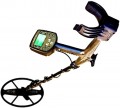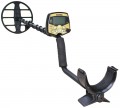Shape
The shape of the coil (frame) of the metal detector.
—
Round. The traditional form used in almost all types of ground and underwater metal detectors (see "Type"); the only exceptions are models that work according to the RF method (see "Operating principle"). When using concentric coils (see "Coil Type"), this option allows you to create a conical field, which is convenient for pinpointing the location of the find, but reduces the covered area and makes it difficult to search over a large area; models with DD coils do not have this drawback.
—
Elliptical. The shape in the form of a longitudinally elongated ellipse allows you to somewhat "stretch" the field created by the metal detector in length. This is especially true for coils of the concentric type — however, such an expansion somewhat reduces the positioning accuracy of individual finds. But in coils of the DD type, where the accuracy is by definition low, the choice between round and elliptical shape is most often not fundamental.
—
Rectangular. A specific form used in RF or PI instruments. For technical reasons, it is considered optimal for such devices, but it is practically not found in other types of metal detectors.
—
Butterfly. Another option used in DD coils along with the ellipse (see above). In fact, it consists of two elliptical windings
..., partially combined and resembling butterfly wings in shape — hence the name. This option is typical mainly for large-sized DD coils; with a large width, it is considered more optimal than an ellipse.Dimensions (WxD)
The size of the standard coil (frame) of the metal detector. Theoretically, the larger it is, the deeper the device is able to “see” and the more space it captures in one pass, but the worse it is suitable for searching for small objects and the lower the accuracy with which it localizes them. At the same time, these characteristics depend on so many other factors that in fact, the size of the coil itself affects them very little.
Note that for coils (frames) of an elliptical shape, only one size can be indicated — along the length.
Detection frequency
The operating frequency (or frequency range) of the metal detector. This is one of the most important parameters when choosing a device, because the optimal frequency for different cases will be different — depending on the size and material of the items being searched, the characteristics of the soil and other factors. Detailed recommendations on the choice of frequency for each specific situation can be found in special sources; And already on the basis of this information, it is worth choosing a specific model.
Note that the actual frequency at which the metal detector will operate also depends on the installed coil — they are usually made for a specific frequency. Therefore, to use the full capabilities of the device with the ability to adjust this parameter, you may need replaceable coils.
Max. detection depth
The greatest depth at which a metal detector is guaranteed to be able to detect a metal object. Note that this parameter is most often quite approximate, moreover, somewhat conditional. This is due to the fact that it is usually indicated for an perfect environment (low-mineralized soil, a fairly large object, the material of which optimally matches the frequency of detection of the coil, etc.), and even for such conditions it is difficult to derive an absolutely accurate value. Therefore, in fact, the detection depth is highly dependent on a number of additional factors (from soil characteristics to user skills) and can be significantly less than indicated in the characteristics. Nevertheless, the claimed depth describes the capabilities of the metal detector quite well, and it is quite possible to compare different models with each other.
Note that a large depth not only increases the cost of the device, but can also adversely affect its ability to detect small objects.
Coin detection depth
The deepest depth at which a metal detector is capable of detecting small coins and other objects of similar size. Many users buy a device with the intention of “hunting” for metal trifles, so manufacturers often indicate this parameter separately in the specifications. Due to the small size of the coins, their detection depth is usually much less than the total maximum detection depth (see above).
Number of modes
The number of pre-installed programs for searching for various materials. Their number reflects the capabilities of a particular model, allowing you to start working right off the bat.
Power source
—
AA. Replaceable elements, known colloquially as "finger" type. They can be both in the form of disposable batteries and in the form of rechargeable batteries. They are produced by many manufacturers, and different brands differ in price and quality, which gives many opportunities to choose the optimal option. And AA batteries are sold almost everywhere. On the other hand, they are usually required in large quantities — about 8, because metal detectors consume quite a lot of energy; and the elements themselves are most often not included in the set.
—
PP3. Replaceable batteries of standard size, in a characteristic rectangular case with a pair of contacts at the end, nominal voltage of 9 V. They are more powerful than the popular AA elements, but they are noticeably less common. They can also be produced in the form of rechargeable batteries.
—
Proprietary battery. Tools powered by its own battery (often built-in), which does not correspond to the standard sizes of replaceable elements. Such batteries can have a high capacity and power and are often more convenient than replaceable elements. In addition, they are usually supplied with the device, which eliminates the need to look for power supply yourself. The main disadvantage of this option is the impossibility of quick replacement in case of exhaustion of the charge — the battery will have to be cha
...rged, and this requires not only a power source, but also time. Theoretically, if the battery is removable, you can keep a spare charged battery ready, but in practice, spare elements are expensive, and it may be difficult to find them. For a number of technical reasons, such type of rower supply is rare, it can be found mainly in high-end models.
— 18650. The name of these batteries comes from their dimensions: 18.6 x 65.2 mm, cylindrical in shape, they look like slightly enlarged AA, but have an operating voltage of about 3.7 V and a higher capacity. In addition, all elements of the 18650 type by definition are not disposable, but rechargeable batteries (lithium-ion type).
— C. Replaceable elements of standard size, cylindrical shape, with a nominal voltage of 1.5 V. In length, they practically do not differ from the AA described above, but they are much thicker, due to that they have a higher capacity. At the same time, this type of power supply is quite rare; this can be said about the batteries themselves as well.Shaft length
The length of a metal detector rod is usually indicated by the distance from the coil to the upper end of the rod (where the armrest is located, if any). The higher the height of the operator, the longer the boom must be so that he can hold the coil above the ground without bending over (or not bending too much). In most models, the length lies in the range from 120 to 145 cm — for most adults this is quite a suitable value. Note that the rods can be adjustable (telescopic) — to adjust for growth.
Weight
The total weight of the metal detector in the working position is with the installed coil and batteries (if both are removable, see above). This parameter is quite important, taking into account the fact that during operation the device has to be kept on the weight: long-term use can be very tiring even with a relatively small weight and the presence of an armrest (see above). Therefore, light weight is a noticeable advantage for any metal detector. At the same time, other things being equal, lighter models tend to cost more, so you can use another option — a shoulder strap that reduces the load on the hand. And for underwater metal detectors (see "Type"), this parameter is not particularly relevant, because. objects underwater lose a significant amount of weight.

